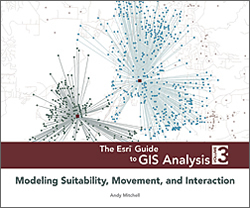ArcUser
Fall 2012 Edition
GIS Modeling Explained and Explored
Modeling Suitability, Movement, and Interaction
By Andy Mitchell
This article as a PDF.

The Esri Guide to GIS Analysis, Volume 3: Modeling Suitability, Movement, and Interaction by Andy Mitchell helps readers explore the basic questions behind GIS analyses, understand the spatial concepts that underlie those questions, and determine appropriate methods to employ when performing GIS analyses that answer those questions. Unlike books that focus on navigating the user interface or on detailing software functionality, this book is concept driven.
Increasingly, GIS is used in many disciplines to provide valuable insights into problems from estimating the path of a wildfire to siting fire stations. This latest volume in the Esri Guide to GIS Analysis series, published in 2012 by Esri Press, helps GIS professionals and students make better use of GIS modeling when evaluating locations or analyzing movement.
Location analysis focuses on the familiar suitability analysis, used to answer questions such as where should the next store be built, as well as unsuitability analysis—analysis that identifies areas to avoid because they have greater risk potential from threats such as flooding or fire.
Analysis of movement includes not only people or animals, which involves some degree of decision making, but also the movement of material such as water, which follows the path of least resistance. In either case, travel is modeled as a cost surface and the analysis determines the route of least cost, whether in terms of money, time, distance, or some other metric.
The analytical process is complex because the questions posed are subjective in nature. They require defining what a suitable site is or which metric is most appropriate when measuring cost. These judgments can be based on the modeler's own expert knowledge of the specific subject, standards or published research in that discipline, or the consensus of area experts (the Delphi process).
Modeling Suitability, Movement, and Interaction gathers analysis methods that have typically been confined to specific disciplines and makes them more widely available. Beyond simply introducing these methods, it also includes best practices associated with implementing them using the ArcGIS platform, its tools, and its modeling framework, ModelBuilder. The scenarios discussed in the text are illustrated with full-color maps and diagrams. A basic familiarity with GIS concepts and ArcGIS desktop software is assumed.
The first book in the Esri Guide to GIS Analysis series, Geographic Patterns and Relationships, explained how GIS is used to identify relationships and trends for better decision making. Spatial Measurements and Statistics, the second in the series, detailed the use of GIS to identify patterns and clusters to analyze geographic relationships using statistics. Mitchell, who wrote the entire series, has written other Esri Press books and has more than 20 years' experience in analyzing and explaining the use of GIS technology. Esri Press, 2012, 432 pp., ISBN-13: 978-1589483057